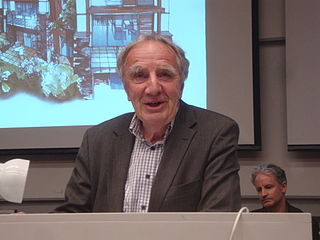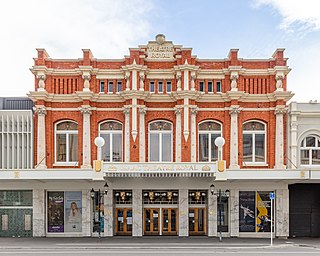
The Beehive is the common name for the Executive Wing of New Zealand Parliament Buildings, located at the corner of Molesworth Street and Lambton Quay, Wellington. It is so-called because its shape is reminiscent of that of a traditional woven form of beehive known as a "skep". It is registered as a Category I heritage building by Heritage New Zealand.

Sir Frederick Miles Warren is a New Zealand architect. He apprenticed under Cecil Wood before studying architecture at the University of Auckland, eventually working at the London County Council where he was exposed to British New Brutalism. Upon returning to Christchurch, and forming the practice Warren and Mahoney, he was instrumental in developing the "Christchurch School" of architecture, an intersection between the truth-to-materials and structural expression that characterised Brutalism, and the low-key, Scandinavian and Japanese commitment to "straightforwardness". He retired from Warren and Mahoney in 1994 but continues to consult as an architect and maintain his historic home and garden at Ohinetahi.

Sir Ian Charles Athfield was a New Zealand architect. He was born in Christchurch and graduated from the University of Auckland in 1963 with a Diploma of Architecture. That same year he joined Structon Group Architects, and he became a partner in 1965. In 1968 he was a principal partner in setting up Athfield Architects with Ian Dickson and Graeme John Boucher (Manson). Athfield died in 2015 due to complications from a routine procedure which resulted in pneumonia, at the Wellington Hospital, where he was being treated for prostate cancer.

The Christchurch Town Hall, since 2007 formally known as the Christchurch Town Hall of the Performing Arts, opened in 1972, is Christchurch, New Zealand's premier performing arts centre. It is located in the central city on the banks of the Avon River overlooking Victoria Square, opposite the former location of the demolished Christchurch Convention Centre. Due to significant damage sustained during the February 2011 Christchurch earthquake, it was closed until 2019. Council staff initially recommended demolition of all but the main auditorium, but at a meeting in November 2012, councillors voted to rebuild the entire hall. In 2020, the town hall was registered as a Category I heritage building.

The Michael Fowler Centre is a concert hall and convention centre in Wellington, New Zealand. It was constructed on reclaimed land next to Civic Square, and is the pre-eminent concert site in central Wellington.

Shane William Cotton is a New Zealand painter whose work explores biculturalism, colonialism, cultural identity, Maori spirituality, and life and death.
The architecture of New Zealand, though influenced by various cultures, expresses predominantly European styles. Polynesian influences emerge in some areas.
Roger Neville Walker is a New Zealand architect based in Wellington.
Margaret Hilda Alington was a New Zealand librarian, historian and author.

Gummer and Ford was an architectural firm founded in 1923 in Auckland, New Zealand, by William Gummer and Charles Reginald Ford. It was among the country's best-regarded architectural firm of the first half of the 20th century, designing numerous iconic buildings, including the former National Art Gallery and Dominion Museum in Wellington and the old Auckland Railway Station. Eighteen of the company's buildings have been registered as significant historic places by Heritage New Zealand. In 2006 an exhibition of their work was staged at The University of Auckland's Gus Fisher Gallery, and in 2007 the firm was described as 'the best architectural practice of all time in New Zealand'.

Clarendon Tower was a high rise building on Worcester Street at Oxford Terrace in the Christchurch Central City, New Zealand. Built on the site of the former Clarendon Hotel, the façade of the historic building was kept in the redevelopment and was protected by the New Zealand Historic Places Trust as a Category II heritage structure. Following damage from the February 2011 Christchurch earthquake, the 17-storey building has been demolished.

Cecil Walter Wood was a New Zealand architect. He was the dominant architect in Canterbury during the interwar period.

Victoria Square is located in central Christchurch, New Zealand. Originally known as Market Place or Market Square, it was the site of market days, fairs, and trade before its redevelopment in 1896–1897 into a park. Subsequent to the February 2011 earthquake, the square was located in the Central City Red Zone and was closed, reopening in November 2012. Its notable landmarks include the Captain James Cook statue, Queen Victoria statue, H. L. Bowker Fountain, and the Victoria Square Poupou. It also features the country's oldest cast iron and stone bridge, now known as the Hamish Hay Bridge.
Ivan Lyall Holmes was a New Zealand structural engineer whose advances in concrete masonry building methods in the 1950s and 1960s were central to the avant-garde style of modernist architecture known as New Brutalism which emerged in the 1950s. It was epitomised locally in the work of architects such as Miles Warren, Maurice Mahoney and Paul Pascoe.

The Crowne Plaza Christchurch, formerly known as the Forsyth Barr Building, is located on the south-east corner of the Armagh and Colombo Streets intersection in Christchurch, New Zealand. Originally owned by Bob Jones and branded Robert Jones House by him, it was commonly referred to as Bob Jones Tower, but some called it Bob's Folly. In the 2011 Christchurch earthquake, its staircases collapsed, trapping the occupants. The building reopened in July 2017 as the city's Crowne Plaza hotel.

The Crowne Plaza in Christchurch, New Zealand, originally known as the Parkroyal Hotel, was a hotel of the Crowne Plaza group. Built in 1988 in the north-west corner of Victoria Square after much public protest, as it cut off the first part of Victoria Street, its construction happened at the same time and enabled the substantial redesign of Victoria Square. The building had New Zealand's largest atrium, and was one of the city's largest hotels. The building suffered significant damage in the 2011 Christchurch earthquake and was demolished in April 2012. The Crowne Plaza group has secured a lease in the Forsyth Barr Building at the opposite end of Victoria Square.

The Isaac Theatre Royal, is a heritage building in Christchurch, New Zealand, designed by brothers Sidney and Alfred Luttrell. Built in 1908 it is the only operational Edwardian style Theatre remaining in New Zealand.
The 2005 Queen's Birthday Honours in New Zealand, celebrating the official birthday of Queen Elizabeth II, were appointments made by the Queen in her right as Queen of New Zealand, on the advice of the New Zealand government, to various orders and honours to reward and highlight good works by New Zealanders. They were announced on 6 June 2005.
The 1985 New Year Honours in New Zealand were appointments by Elizabeth II on the advice of the New Zealand government to various orders and honours to reward and highlight good works by New Zealanders. The awards celebrated the passing of 1984 and the beginning of 1985, and were announced on 31 December 1984.













